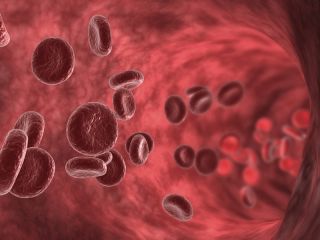
The Circulatory System
The Circulatory System
The circulatory system in humans is a closed type system. It consists of three components.
• A powerful pumping organà heart
• Vesselsà to transport the compounds.
• Bloodà medium of transport.
Double Circuit Plan:
Humans circulatory system has a double circuit plan. That is the heart serves as two pumps.
The right side of the heart pumps blood to the lungs.
The left side of the heart pumps oxygenated blood to the whole body.
Blood Vessels:
Arteries
• They carry blood away from the heart.
• They have a smaller lumen and thick walls.
• The blood in the arteries is at high pressure.
• Walls of arteries have elastic fibers that help in maintaining the pressure inside.
• There are no valves in arteries as the blood is at high pressure.
Capillaries
• Capillaries' wall is just one cell layer thick.
• Thin walls reduce the diffusion distance and help in the transport of substances.
• The pressure in capillaries is low.
Veins
• They carry blood back to the heart.
• They have a large lumen and the walls are thin as compared to arteries.
• Blood in veins is at low pressure.
• Veins have a valve to prevent the backward flow of blood.
• The blood from the lower body is transported in veins through the squeezing action of the muscles of the leg.
Pressure Changes In The Vessels
The pressure of blood in arteries is high due to the pumping action of the heart. To maintain this pressure the walls of arteries are elastic.
The pressure decreases the blood is moved away from the heart. Thus, capillaries are at low pressure. Their total cross-section is less than arteries which is one reason for low pressure.
The blood in the vein is at the lowest pressure due to the increasing distance from the heart.
Components Of Blood
Blood has two components.
The liquid portion is called plasma which makes up 55% of total blood.
The solid portion consists of blood cells which make up 45% of blood.
Blood Cells Or Corpuscles
Red Blood Cells
> Red blood cells are biconcave cells. This helps them in squeezing out through capillaries. It also increases the surface area for diffusion.
> They contain hemoglobin which transports oxygen.
> RBCs have no nucleus, mitochondria, and other organelles.
White Blood Cells
> They are associated with the defense of the body.
> There are two types of white blood cells. Phagocytes and lymphocytes
Phagocytes
> They remove the harmful organisms by engulfing or phagocytosing them.
> They have a multilobed nucleus.
Lymphocytes
Recognize viruses and bacteria as foreign bodies and initiate a response to remove them.
Platelets
Fragments from large cells.
It helps in blood clotting.
Tissue Fluid And Lymph
At the arteriolar end of capillaries, the pressure is high. This results in leakage of fluid from the blood into the tissue spaces. This fluid is called tissue fluid.
Tissue fluid has the same composition as blood. The difference is that it does not contains blood cells and albumin.
It bathes the cells. Substances are diffused from the blood into the tissue fluid and then diffuse into the cells.
At the venular end, the pressure is low. Thus the fluid seeps back into the veins. Although a little amount is left behind.
This leftover fluid then enters the lymphatic vessels as lymph. Lymph moves through the lymphatic system and is transported back to the blood.
Difference Between Blood Tissue Fluid And Lymph
Blood is the suspension of blood cells in the plasma.
Tissue fluid is the fluid component of blood leaked through filtration.
Lymph is the tissue fluid that enters the lymphatic system for drainage.
Hemoglobin And Oxygen Transport
Each hemoglobin molecule has four polypeptide chains. Each chain has a heme group that has Fe+2 iron. This iron can bind with 2 oxygen atoms.
Each chain can carry 2 oxygen atoms thus each hemoglobin molecule carries 8 oxygen atom.
Oxygen concentration is measure as partial pressure or pO2.
At high pO2 oxygen binds with more oxygen than it does at low pO2. Thus, at high pO2 hemoglobin is completely saturated.
The Bohr Effect
The amount of hemoglobin saturation not only depends on pO2 but also on the pH of the blood.
The decrease in pH causes a decrease in hemoglobin saturation. Thus, the oxygen is released from the hemoglobin.
An increase in Co2 causes an increase in H+. Thus decreases the pH.
Thus in areas of blood where CO2 is high the hemoglobin will lose oxygen. This release of oxygen is called the Bohr effect.
Hemoglobin also helps in mopping up extra H+ ions thus they act as buffers.
CO2 Transport
About 85% of carbon dioxide enters the red blood cells. Here they react with water to form carbonic acid in the presence of carbonic anhydrase.
5% of carbon dioxide dissolves in the plasma.
The rest of the carbon dioxide also enters red blood cells but instead of forming carbonic acid, they combine with hemoglobin to form carbaminohemoglobin.
Adaptation To High Altitude
At high altitude the pO2 is low and the air is less dense. Thus hemoglobin saturation is decreased. To counter this after some time the red blood cells in the blood are increased. Thus, the oxygen-carrying capacity of blood is increased although each hemoglobin is carrying less oxygen.
